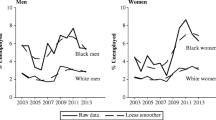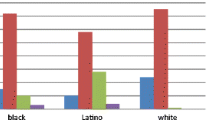Abstract
The persistent relationship between race and unemployment among young men and women has been among the most vexing problems faced by Black communities in the Post-Civil Rights era. Researchers have tried to identify mechanisms through which racial status continues to bear on employment status by identifying individual attributes that render workers of different racial identities similarly likely to secure employment. When Black and White workers with similar human capital profiles have different odds of employment, we are left to speculate about what is behind those differences. In this paper, I demonstrate that racial differences in the odds of unemployment are greater in some states than in others and suggest that some part of the racial employment gap can be explained by state-level attributes. First, however, we must identify convincing measures of the strength of association between race and employment status across states. I offer four such measures and rank the states on each. We are left with some surprising answers to the question “where does race matter most?” and empirical foundations for a research agenda that sheds new light on racial employment gaps by treating labor markets rather than labor market participants as the units of observation.
Similar content being viewed by others
Notes
This paper treats states and labor markets as contexts in which job opportunities are allocated more or less equitably. Therefore, those three terms—states, labor markets, and contexts—are used interchangeably throughout the paper.
In this paper, the odds of unemployment will be estimated and compared rather than the odds of employment; the results are the same but are better described as measures of Black disadvantage whereas Cohn and Fossett’s (1995) results are better described as estimates of White advantage.
Idaho, Maine, Montana, New Hampshire, North Dakota, South Dakota, Vermont, and Wyoming are excluded from the analyses of Black disadvantage because their samples contain fewer than 100 Black workers.
White, Black, American Indian, Latino, Asian, Southeast Asian/Pacific Islander, Arab/Middle Eastern, and “Other”.
References
Austin, A. (2013). The unfinished march: An overview. Washington, DC: The Economic Policy Institute.
Becker, G. S. (1957). The economics of discrimination. Chicago: The University of Chicago Press.
Beggs, J., Villemez, W., & Arnold, R. (1997). Black population concentration and black-white inequality. Social Forces, 76, 65–91.
Bertrand, M., & Mullainathan, S. (2004). Are Emily and Greg more employable than Lakisha and Jamal? A field experiment on labor market discrimination. American Economic Review, 94(4), 991–1013.
Blalock, H. (1956). Economic discrimination and negro increase. American Sociological Review, 21(5), 548–588.
Blalock, H. (1967). Toward a theory of minority group relations. New York: Wiley.
Bonacich, E. (1972). A theory of ethnic antagonism: The split labor market. American Sociological Review, 37(5), 547–559.
Brand, J. (2015). The far-reaching impact of job loss and unemployment. Annual Review of Sociology, 41, 1.1–1.17.
Cohn, S., & Fossett, M. (1995). Why racial employment is greater in the northern labor markets: Regional differences in White-Black employment differentials. Social Forces, 74(2), 511–542.
Emeka, A. (2009). Race and unemployment amidst the new diversity: More evidence of a black/non-black divide. Race and Social Problems, 1, 157–170.
Feagin, J. (2006). Systemic racism: A theory of oppression. New York: Routledge.
Fryer, R. G., Pager, D., & Spenkuch, J. (2013). Racial disparities in job finding and offered wages. Journal of Law and Economics, 56(3), 633–689.
Hill, H. (1985). Black labor and the American legal system: Race, work, and the law. Madison: University of Wisconsin Press.
Holzer, H. (1998). Why do small establishments hire fewer blacks than large ones? Journal of Human Resources, 32, 896–914.
Long, S. (1997). Regression models for categorical and limited dependent variables. Thousand Oaks: Sage Publications.
Lucas, S. (2009). Theorizing discrimination in an era of contested prejudice. Philadelphia: Temple University Press.
Lucas, S. (2013). Just who loses: Discrimination in the United States. Philadelphia: Temple University Press.
Moss, P., & Tilly, C. (2001). Stories employers tell: Race, skill, and hiring in America. New York: Russell Sage.
Neckerman, K., & Kirschenman, J. (1991). Hiring strategies, racial bias, and inner-city workers. Social Problems, 38(4), 433–447.
Pager, D. (2003). The mark of a criminal record. American Journal of Sociology, 108(5), 937–975.
Pager, D., Western, B., & Bonikowski, B. (2009). Discrimination in a low-wage labor market: A field experiment. American Sociological Review, 74(5), 777–799.
Ruggles, S., Genadek, K., Goeken, R., Grover, J., & Sobek, M. (2015). Integrated public use microdata series: Version 6.0 [Machine-readable database]. Minneapolis: University of Minnesota.
Shulman, S. (1991). Why is the black unemployment rate always twice as high as the white unemployment rate? In R. Cornwall & P. Wunnava (Eds.), New approaches to the economic and social analyses of discrimination. New York: Praeger.
Skaggs, S. (2009). Legal-political pressures and African American access to managerial jobs. American Sociological Review, 74, 225–244.
Stainback, K., & Tomaskovic-Devey, D. (2012). Documenting desegregation: Racial and gender Segregation in private-sector employment since the civil rights act. New York: Russell Sage Foundation.
Thurow, L. (1975). Generating inequality: Mechanisms of distribution in the US economy. New York: Basic Books.
Waldinger, R., & Lichter, M. I. (2003). How the other half works: Immigration and the social organization of labor. Oakland: University of California Press.
Wilson, W. J. (1996). When work disappears: The world of the new urban poor. New York: Vintage Books.
Wilson, W. J. (2009). More that just race: Being black and poor in the inner city. New York: W.W. Norton.
Wilson, F. D., Tienda, M., & Wu, L. (1995). Race and unemployment: Labor market experiences of Black and White men, 1968–1988. Work and Occupations, 22(k3), 245–270.
Acknowledgements
I wish to thank Dr. Elizabeth Hirsh and Dr. Catherine Berheide for their close readings and thoughtful commentaries on early drafts of this paper as well as Rebecca Datus, Taylor Sczymecki, and Mollie Welch for their assistance at the various stages of data gathering and reporting associated with this project. I am solely responsible for any shortcomings of the work.
Author information
Authors and Affiliations
Corresponding author
Rights and permissions
About this article
Cite this article
Emeka, A. Where Race Matters Most: Measuring the Strength of Association Between Race and Unemployment Across the 50 United States. Soc Indic Res 136, 557–573 (2018). https://doi.org/10.1007/s11205-017-1557-9
Accepted:
Published:
Issue Date:
DOI: https://doi.org/10.1007/s11205-017-1557-9




